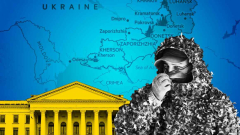A small group of battle-hardened snipers in Ukraine’s 93rd mechanised brigade recently received a disheartening order: rush back to the frontline near Pokrovsk where they had been positioned two months ago. Russian troops had just advanced some 10km, one of their biggest gains this year.
“I looked at the map and my eyes went wide,” said “Shepherd”, 36, a staff sergeant who oversaw the deployment and who would only gave his call sign for security reasons.
Sent along with troops from other Ukrainian brigades, they ultimately succeeded in containing the Russian advance and even recaptured several settlements north of the strategically important city, according to Ukraine’s general staff and independent assessments by war monitoring groups.
“It could have gone really badly for everyone,” Shepherd told the Financial Times at a training ground near the frontline. Had the Russian forces pressed ahead, he added, they could have completely encircled Pokrovsk and bypassed defences in the Kramatorsk area, setting the stage for further advances.
The Russian incursion brought into sharp focus the military relevance of the fortified cities and towns in the east that Ukraine still controls. Russian President Vladimir Putin is demanding that Kyiv cede the entire Donetsk and Luhansk regions, collectively known as the Donbas.
Ukrainian President Volodymyr Zelenskyy has rejected the proposition, even as US President Donald Trump said a peace deal would likely involve “some swapping of territories”.
Russian forces have intensified their offensive along the entire frontline, entering a forest north of Slovyansk and creeping closer to Kostyantynivka, according to independent groups monitoring the Russian advances.
In the Kharkiv region, fighting has also begun on the northern outskirts of Kupyansk, a town seized by Russia in the early hours of its 2022 invasion that reverted back into Ukrainian hands a few months later.
A Ukrainian military spokesperson on Wednesday admitted that Russian troops were “trying to gain a foothold” in the Dnipropetrovsk region — an area which has not been under Russian control.
The idea of simply giving up the Donbas was met with outrage across the region. At the Donetsk training ground, “Nikitos”, a 25-year-old sniper from Horlivka, a town in eastern Ukraine now under Russian control, stayed silent for a moment when asked how he would react if his brigade was ordered to pull out.
“There won’t be such an order,” he said. “I don’t believe it”.

The matter is not simply one of principle or legality, Ukrainian officials and soldiers say. In northern Donetsk, a 45km belt of heavily-fortified cities and smaller settlements dotted along a key road now represents a formidable barrier — the last major line of defence in the region.
“Beyond this, you have open terrain, no large industrial agglomerations, no areas that would make it possible to build a stable defence,” said Dmytro Zaporozhets, spokesperson for Ukraine’s newly formed 11th army corps.
The “fortress belt” begins at the southern tip of Kostyantynivka, a town with a prewar population of around 65,000. Russian forces have been gradually approaching the city from three directions, recently getting within 10km of its outskirts.
The road linking Kostyantynivka to Kramatorsk is now littered with charred vehicles as military trucks and evacuation SUVs barrel down a road lined with anti-drone nets.
“It’s become way more dangerous in recent weeks,” said Evgeny Tkachev, a humanitarian worker. He spoke to the FT just after completing four evacuation runs from




